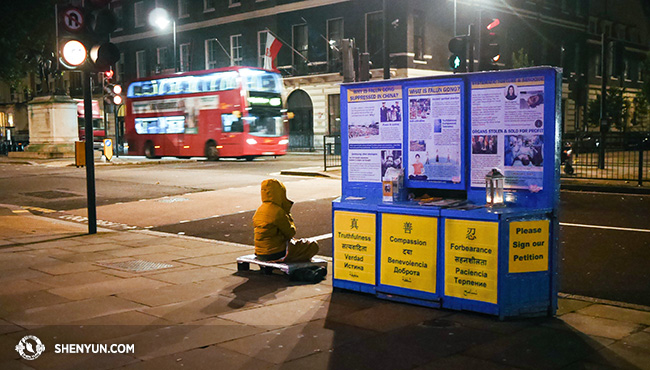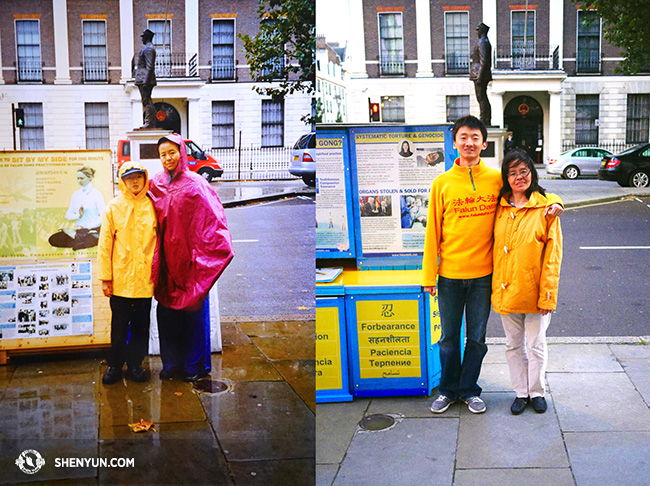
The Divine Renaissance Begins—that’s the name of one our ending pieces, which we performed a couple years back. The dance opens with a group of people doing the Falun Gong meditation exercises, mirroring the same movements practiced by a hundred million worldwide. The story then follows two protagonists, the persecution they encounter, and the universe’s eventual redemption.
During a hectic rehearsal season, roles were being switched around. A month before tour, one of those landed on me. I remembered it being a confusing experience having to learn a fresh role two days before dress rehearsal.
As we wrapped up the year’s tour, though, I came to realize that it didn’t matter who was in what role anymore. What mattered were the characters being portrayed. As the curtain flew out for the final time on every show, more strongly than ever before, I could feel the joy of dancing for others. What matters is their story—the story that is also, in a way, my own…
…
June 5, 2002. 66 Portland Place, London. In the mild English summer, a little boy and his mom join a dozen other people. They sit down on the sidewalk facing the Embassy of the People’s Republic of China, close their eyes, and meditate. They have begun a round-the-clock, 24/7 peaceful sit-in.
Over the next months, the little boy sleeps in a roadside tent, eats from lunch boxes, and updates the day-count on the display board with inserted paper numbers, much to his own amusement. On weekday mornings, he wakes up, steps out of the tent, puts on a British school uniform, brushes his teeth at McDonalds, and commutes an hour on the tube to his suburban school. In the afternoon, he’s back, doing his homework on the pavement.

These sit-ins, or what we called “appeals,” outside Chinese diplomatic missions in different countries was one of the many efforts initiated by Falun Gong practitioners around the world to oppose to the inhumane oppression of their fellow believers in China. The persecution had started on July 20, 1999 and the death toll from torture in custody was rising, and continues to rise today, every day. The key for us was to get the word out, to tell the Chinese people and the international community alike what was going on—this, at a time when the whole world was fed lies about us by the Chinese Communist Party’s overwhelming propaganda machine.
So we gave our all. We held big parades, candlelight vigils, and press conferences. Other Falun Gong practitioners established independent overseas websites and newspapers, broke through the Great Internet Firewall of China, called Chinese prisons and police stations, and filed lawsuits against perpetrators in international courts. We told anyone who would listen about the persecution—from the general public to government officials to Chinese tourists.
You could see these old grandmas and grandpas handing out flyers at Trafalgar Square and Cambridge, just as you could see them in front of the Eiffel Tower or the Sydney Opera House. Undaunted by sometimes being cursed, spat on, condemned as “bringing shame on China,” and even slapped in the face, they’ve braved humiliation and the elements to persist day after day, year after year. For 17 years now. Ever so patiently, with words of compassion, they’ve dispelled the lies and told the world the truth about what is happening to Falun Gong in China.
No other sit-in outside a P.R.C embassy around the world has lasted as long as the non-stop London site. Sometimes, other human rights groups would turn up to shout slogans at the art deco building across the street. But even as they did, the peaceful meditators kept standing up for their cause—by sitting down. Arriving at their allotted shifts according to a volunteer schedule, they practiced the slow exercises of Falun Dafa, never failing to strive for peace of mind amidst the roar of London traffic…
…
As the day count outside the Chinese embassy reaches 100, it is time to squeeze in a third digit on the display board. The little boy adds a new plastic slot for the paper numbers, and asks his mom: “Mom, when do we not have to protest here anymore?” Mom’s answer is simple and unforgettable: “When the persecution ends.”

A decade later, the boy and his mom are an ocean apart. Mom is still at it—sometimes taking a night shift, going straight to work in her city-center office the next morning.
But the boy is gone. His journey has taken him thousands of miles, from the London sidewalk to the world stage. The English drizzle has been replaced by dazzling theater lights. The rumble of double-decker buses has been replaced by the euphony emanating from the orchestra. The occasional passersby have transformed into packed houses of gentlemen and ladies bedecked in their best evening attire. And the deceived Chinese tourists, those who used to spit and curse, have been replaced by Chinese theatergoers in the audience, proudly reclaiming the traditional culture that was once almost lost.
The little boy, the once-silent protester, has found a powerful voice—in the silent art of dance.
So can you picture his excitement, as the curtain flies up for the last time, revealing a scene and a story from today’s China? Can you imagine his joys and sorrows, as teenage nostalgia and a decade of perseverance in wind and rain come flooding back to him in a moment on stage? He feels honor and pride and liberation in being able to dance not just for himself, but for his mom sitting outside the embassy, the grandmas and grandpas with their flyers, the millions still suffering indescribable torture, detention, and oppression in China, and for the even greater millions worldwide who share the belief—that goodness will prevail.
* * *
Editor's Update: A documentary has been made about the story of Ben Chen and the 24-hour vigil called "Candlelight Across the Street." You can watch it on YouTube here.




